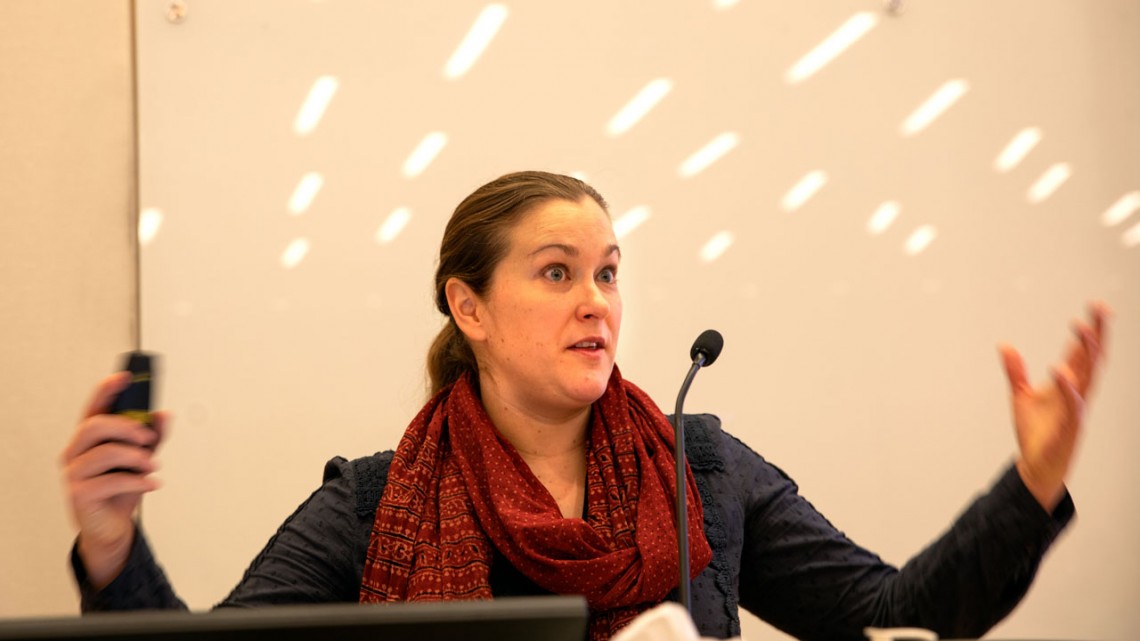
Jennifer Ifft, assistant professor of applied economics and management, gives her analysis of New York state's agriculture economy Jan. 18 at the 2019 Agricultural and Food Business Outlook conference in Stocking Hall.
NY’s ag economy faces low profits, big risks
By Susan Kelley
The outlook for New York state’s farm economy is steady, with farm incomes likely to remain relatively low for a second straight year.
New York state farm income for 2017 – the latest data available – was $1.25 billion. At a 10-year low, that figure is near the historic average and is likely to extend into the next year, said Jennifer Ifft, assistant professor of applied economics and management, who spoke Jan. 18 at the 2019 Agricultural and Food Business Outlook conference.
“The best-case scenario is people are making a small profit,” Ifft said. “The worst case is you have family farms that are going out of business.”
The annual agricultural economics conference, presented by faculty of the Charles H. Dyson School of Applied Economics and Management, covered the latest data and research on the national and New York state economies.
Milk prices could increase slightly in 2019, offering one bright spot. “There is some small upside for dairy, in terms of prices,” Ifft said. “But there’s not a lot of upside right now, generally, for the agriculture industry. And there is lot of downside.”
For example, trade is a huge source of uncertainty, she said. And wages for farmworkers – one of the biggest expenses for New York farms – saw a dramatic increase from 2014 to 2017, she said. “I wouldn’t expect this to go down at all in the future, with our tight labor supply, with the minimum wage laws continuing to kick in,” Ifft said, noting that interest rates and feed expenses are also likely to continue to rise in 2019.
However, New York’s cropland and pasture values have stayed steady since 2012. “Generally, these are important to look at because farmland makes up about 75 to 80 percent of farm assets,” she said. “As long as you have people who want to buy farmland, you’re still going to see these steady levels of value.”
Ifft sees significant innovation happening in the farm sector, she said. “People are exploiting all sorts of new markets and crops,” she said, such as hemp, an area in which Cornell has done significant research.
And renewable energy production could be an option for some farms, she said, thanks in part to the state’s ambitious goal of getting 50 percent of its electricity from renewable sources by 2030.
Solar developers are looking for a specific type of land – flat, dry, unshaded, close to roads and transmission lines, with few close neighbors – which also happens to be good for most types of agriculture. “It doesn’t work for all land,” Ifft said, noting renewable energy production could fragment agricultural land, increase the price of land for those who rent it, and present challenges when the useful life of the energy facilities – such as wind turbines and solar panels – is over.
“But it is an opportunity right now for a lot of landowners,” she said, especially where land with solar panels can be farmed or used to graze livestock. The practice, known as co-location or solar grazing, has many environmental advantages and potential tax benefits, makes mowing unnecessary, and is a public relations win for solar developers, she said. Studies on solar grazing are ongoing at Cornell.
“In places where we see high potential for renewable energy production, I would expect to see farmland values go up,” Ifft said. “I think there are a lot of opportunities for New York agriculture, but there’s certainly no single recipe for success.”
Media Contact
Get Cornell news delivered right to your inbox.
Subscribe

